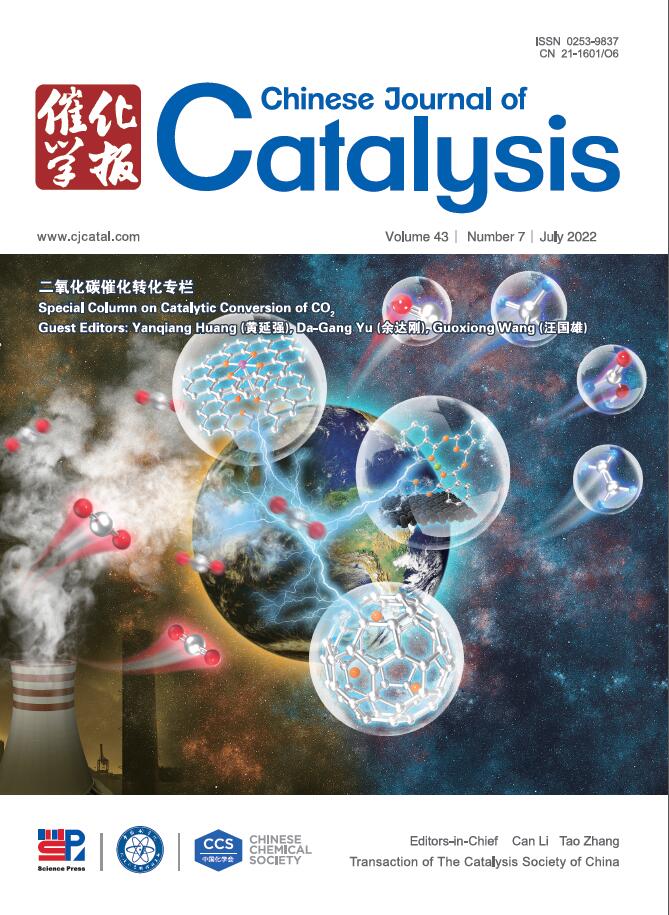Unraveling the Ni-Co synergy in bifunctional hydroxide cocatalysts for better cooperation of CO2 reduction and H2O oxidation in 2D S-scheme photosynthetic systems
IF 15.7
1区 化学
Q1 CHEMISTRY, APPLIED
引用次数: 0
Abstract
ABSTRACT
Layered transition metal hydroxides show distinct advantages in separately co-catalyzing CO2 reduction and H2O oxidation at the electron-accumulating and hole-accumulating sites of wrapped heterojunction photocatalysts, while concurrently preventing side reactions and photocorrosion on the semiconductor surface. Herein, Ni-Co bimetallic hydroxides with varying Ni/Co molar ratios (NixCo1–x(OH)2, x = 1, 0.75, 0.5, 0.25, and 0) were grown in situ on a model 2D/2D S-scheme heterojunction composed of Cu2O nanosheets and Fe2O3 nanoplates to form a series of Cu2O/Fe2O3@NixCo1–x(OH)2 (CF@NiCo) photocatalysts. The combined experimental and theoretical investigation demonstrates that incorporating an appropriate amount of Co into Ni(OH)2 not only modulates the energy band structure of NixCo1–x(OH)2, balances the electron- and hole-trapping abilities of the bifunctional cocatalyst and maximizes the charge separation efficiency of the heterojunction, but also regulates the d-band center of NixCo1–x(OH)2, reinforcing the adsorption and activation of CO2 and H2O on the cocatalyst surface and lowering the rate-limiting barriers in the CO2-to-CO and H2O-to-O2 conversion. Benefiting from the Ni-Co synergy, the redox reactions proceed stoichiometrically. The optimized CF@Ni0.75Co0.25 achieves CO and O2 yields of 552.7 and 313.0 μmol gcat–1 h–1, respectively, 11.3/9.9, 1.6/1.7, and 4.5/5.9-fold higher than those of CF, CF@Ni, and CF@Co. This study offers valuable insights into the design of bifunctional noble-metal-free cocatalysts for high-performance artificial photosynthesis.
揭示双功能氢氧化物助催化剂中Ni-Co的协同作用,促进二维S-scheme光合系统中CO2还原和H2O氧化的更好合作
摘要层状过渡金属氢氧化物在包裹异质结光催化剂的电子聚集和空穴聚集位点分别共催化CO2还原和H2O氧化,同时防止半导体表面的副反应和光腐蚀方面具有明显的优势。本文在由Cu2O纳米片和Fe2O3纳米片组成的2D/2D s型异质结上原位生长不同Ni/Co摩尔比(NixCo1-x (OH)2、x = 1、0.75、0.5、0.25和0)的Ni-Co双金属氢氧化物,形成一系列Cu2O/Fe2O3@NixCo1 -x (OH)2 (CF@NiCo)光催化剂。实验与理论相结合的研究表明,在Ni(OH)2中加入适量的Co不仅可以调节NixCo1-x (OH)2的能带结构,平衡双功能助催化剂的电子和空穴捕获能力,最大限度地提高异质结的电荷分离效率,还可以调节NixCo1-x (OH)2的d带中心。增强了co和H2O在助催化剂表面的吸附和活化,降低了co -to- co和H2O-to- o2转化过程中的限速障碍。得益于镍钴的协同作用,氧化还原反应以化学计量的方式进行。优化后的CF@Ni0.75Co0.25的CO和O2产率分别为552.7和313.0 μmol gcat-1 h-1,比CF、CF@Ni和CF@Co分别高11.3/9.9、1.6/1.7和4.5/5.9倍。该研究为高性能人工光合作用的双功能无贵金属共催化剂的设计提供了有价值的见解。
本文章由计算机程序翻译,如有差异,请以英文原文为准。
求助全文
约1分钟内获得全文
求助全文
来源期刊

Chinese Journal of Catalysis
工程技术-工程:化工
CiteScore
25.80
自引率
10.30%
发文量
235
审稿时长
1.2 months
期刊介绍:
The journal covers a broad scope, encompassing new trends in catalysis for applications in energy production, environmental protection, and the preparation of materials, petroleum chemicals, and fine chemicals. It explores the scientific foundation for preparing and activating catalysts of commercial interest, emphasizing representative models.The focus includes spectroscopic methods for structural characterization, especially in situ techniques, as well as new theoretical methods with practical impact in catalysis and catalytic reactions.The journal delves into the relationship between homogeneous and heterogeneous catalysis and includes theoretical studies on the structure and reactivity of catalysts.Additionally, contributions on photocatalysis, biocatalysis, surface science, and catalysis-related chemical kinetics are welcomed.
 求助内容:
求助内容: 应助结果提醒方式:
应助结果提醒方式:


